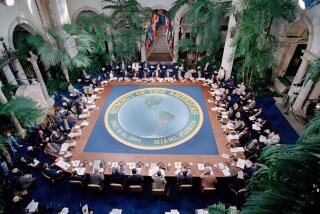Building on Reykjavik
- Share via
For a few more days, the struggle for control of the U.S. Senate will upstage the struggle for control of nuclear arms. Then Washington can get back to the lessons of the Reykjavik summit.
Perhaps the intrusion of politics was useful. The Reagan team’s frowns of failure at the summit’s end, the painted smiles of success that replaced them, the fudging in Washington over just how far President Reagan and General Secretary Mikhail S. Gorbachev moved toward disarmament are history. What counts, now, as it did then, is the future and, details aside, Reykjavik is a foundation on which to build.
The central meaning of the conversations in Iceland is that the two leaders understand that the arms race has gone far enough and that they should be cutting their nuclear arsenals, not adding to them. An outline for achieving that--born at Reykjavik--is on the table in Geneva.
Reykjavik also showed that there can be no deal on offensive nuclear weapons without a negotiated deal on defensive weapons.
Gorbachev’s price for cuts in missiles was a slowdown in Star Wars, a price the President was not then prepared to pay. Gorbachev’s price should have come as no surprise to Reagan. His own defense secretary, Caspar W. Weinberger, told him a year ago that an expanded Soviet defense network would require the United States to build more American offensive missiles.
Soviet officials are not likely to cut offensive weapons without knowing where the U.S. defense project is going. Americans cannot design a sensible defense system without knowing how many offensive missiles the Soviets have. Unless ground rules are negotiated for defense systems in both countries, there is little hope that either would, in the end, agree to cuts in offensive weapons. Any attempt to negotiate on other grounds would just leave the teams at Geneva talking in offensive-defensive circles.
The President does not have to give up much to bargain on defenses. The wheels have pretty much come off of his grandiose version of Star Wars anyway. A growing majority of scientists reject his claims that a shield can be built to protect all America from nuclear weapons; they still support research, as do we, although at a slower and more disciplined pace. And the major Star Wars debate in Washington in 1987 will not be over the President’s vision but over using technology at hand to defend American missile silos.
Congress is losing its taste for billions of dollars it will take under the President’s crash research program just to find out what Star Wars might and might not do. As Sen. William R. Cohen (R-Maine) told National Journal recently, the country doesn’t have the resources to commit to a program for which there still is “no architecture.”
Not long after the President proposed Star Wars in 1983, a defense analyst said that the system would never work but it would serve a purpose anyway by shaking up decades-old beliefs about arms control and the value of deterring war with the threat of devastating retaliation for any first strike. Shaking up those beliefs has led both countries back to the basics. Arms control started out as something that would come in stages, with each successive treaty moving the world away from the dangers of nuclear war.
The goal was set at Reykjavik. The experts at Geneva now can get closer to the goal by filling in the details--how to balance offense and defense, what to do with conventional weapons--and produce something that both the President and the General Secretary can comfortably sign.
More to Read
Sign up for Essential California
The most important California stories and recommendations in your inbox every morning.
You may occasionally receive promotional content from the Los Angeles Times.













